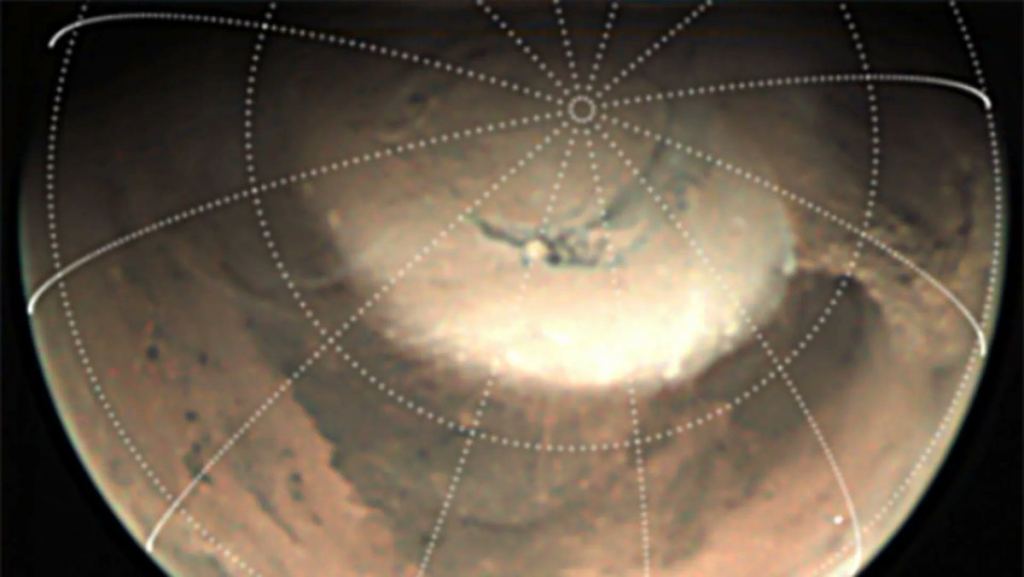One of the benefits of having a cluster of satellites orbiting another planet is that scientists can then analyze that planet’s weather. Sometimes in that process, they find patterns that are strikingly similar to those found on our home planet. That was the case recently when a group of scientists from ESA used data from Mars Express to analyze cloud formation on Mars.
To no one’s surprise, dust seemed to be at the core of that formation. But the resultant clouds looked very much like those found here on Earth – in the tropics. The paper, recently published in Icarus, utilized data from two of Mar Express’ cameras: the Visual Monitoring Camera (VMC) and the High-Resolution Stereo Camera (HRSC), and another camera on the Mars Reconnaissance Orbiter.
All of those cameras were focused on one particular event – the formation of clouds surrounding the Martian North Pole during its springtime. Cloud formation is common in that location at that time of year, but this is the first time so much data-collecting power has been turned toward it. In particular, two notable dust storms formed during the springtime of 2019, when the data for the paper was collected.
That data included actual photographs that showed something familiar to storm watchers on Earth – spiral patterns. A hurricane-like spiral storm on Mars. Credit – ESA / DLR / FU Berlin One of the most distinct pictures from the HRSC images shows a spiral pattern that seemed very similar to a hurricane (or cyclones as they are called in some parts of the world) on Earth.
They reach between 1000 and 2000 km in size and are thought to be caused by similar patterns to those that form hurricanes here. Similarities between Earth and Martian clouds don’t stop there. Some of Earth’s more picturesque cloud formations involve a “texturing” pattern that makes them look like sand.
A similar pattern happens on Mars, and “textured” clouds can be seen in some of the images Mars Express sent back. These textures are formed by a convection pattern where, on Earth, air containing water is heated by the Sun, causing it to rise, and eventually, the water condenses to form clouds. On Mars, however, water is not so readily available, so the Sun heats the dust-laden air, causing it to rise similarly and then fall into gaps between the pockets of hot air containing the dust.
This overall “closed-cell convection” causes the textured pattern seen in the image. Mars’ atmosphere has been gone for some time – could we bring it back? Mars and Earth aren’t the only places this phenomenon occurs, though. Venus also has closed-cell convection, as evidenced by data collected by Mars Express’ sister craft – Venus Express.
Since Venus also lacks significant water and has a much thicker atmosphere than either Earth or Mars, it seems the fundamental processes that cause these cloud formations don’t care much about that part of the environment, at least. Finding similar patterns elsewhere in the solar system is both comforting and enlightening. Using those similarities to help predict Martian weather, especially for future crewed missions, is one way that long-standing missions such as Mars Express can continue to help contribute to humanity’s long-term exploration of space.
Learn More:ESA – Martian dust storms churn up Earth-like cloudsSánchez-Lavega et al. – Cellular patterns and dry convection in textured dust storms at the edge of Mars North Polar CapUT – Martian Clouds Might Start with Meteor Trails Through the AtmosphereUT – Every Spring a Single Cloud Forms at one of Mars’ Tallest Mountains and Only Lasts for a few Hours Lead Image:Image of a dust storm on Mars. Credit – ESA / GCP / UPV / EHU Bilbao The post Many Clouds on Mars are Driven by Dust, not Water appeared first on Universe Today.
.
From: universetoday
URL: https://www.universetoday.com/158813/many-clouds-on-mars-are-driven-by-dust-not-water/



